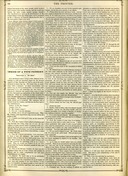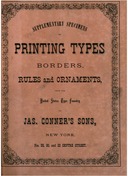1829 - 1892. New York. James Conner (d. 1861). Started a stereotype plant in 1827. In 1829 obtained the services of Edwin Starr (who most recently had been at the Edwin & Richard Starr foundry) to start the foundry side of his own business. Conner may have purchased the materials of the Edwin & Richard Starr foundry from their brother Charles Starr (as Annenberg says on p. 114). (Or they may have gone to any of several other locations.) James Conner died in 1861; firm renamed James Conner's Sons (William C. Conner, James Madison Conner (d. 1887), and (no financial interest but active in firm) Charles S. Conner).
In 1856 sold a complete foundry outfit to Edward Miller, late of the Albany Type Foundry, who took it to Milwaukee and established the Northwestern Type Foundry.
Amalgamated with American Type Founders at its creation in 1892. Charles S. Conner (son of James Madison Conner). managed the Baltimore branch of ATF. Benjamin Franklin Conner (also son of James Madison Conner) established Conner, Fendler & Co. and Bentley, Conner & Co., both of which sold, but may or may not have cast, type.
(Most of the information above from {Annenberg 1994}.)

"Inside of a Type Foundry." (1858)
[Anon., probably David Bruce, Jr.] "Inside of a Type Foundry." The Printer, Vol. 1, No. 6 (October 1858): 116-117.
This article is unsigned, but is probably by David Bruce, Jr. He was at this time writing a series of articles on the "Art of Type Founding" for The Printer, and certain stylistic aspects of this article are very much in keeping with that series. It is interesting insofar as it discusses Bruce's pivotal type caster and the extension to at least one of his patents. It is also interesting for its emphasis on the various stages of finishing types (as well as its admission that these were done by female and child labor) and its sharp criticism of electroformed matrices. (In the 1880s, the Conner foundry would object strongly to Carl Schraubstadter's advocacy of electroformed matrices.)
Scanned by Stephen O. Saxe from his copy. My thanks to him for this scan - which for technical reasons was not easy to make.

James M. Conner. ["Electrotype Matrices."] (1887)
In late 1887, James Madison Conner, of the James Conner's Sons type foundry (the United States Type Foundry, in NY) wrote a response to Carl Schraubstadter's March 1887 Inland Printer article (q.v.) . It was published in the Conner foundry's house organ, The Typographic Messenger. I have not yet seen a copy of this, but his (Conner's) article was reprinted in a New Zealand printing trade publication called Typo (see below) .
(The blank icon at left links up-and-over to the as-yet-non-presentation of this item in the Notebook of literature on Electroforming Matrices.

James M. Conner. "Electrotype Matrices." ([1887] 1888)
Conner, James M[adison]. "Electrotype Matrices." Typo: A Monthly Newspaper and Literary Review. Vol. 2, Issue 15 (1888-03-31): 22. This is a reprint of James Madison Conner's 1887 article in The Typographic Messenger (see above) .
Several volumes of this periodical have been reprinted digitally by the New Zealand Electronic Text Collection at the Victoria University of New Zealand Library: http://nzetc.victoria.ac.nz/tm/scholarly/tei-corpus-typo.html They've licensed their digital versions of this material under the Creative Commons Attribution-ShareAlike 3.0 New Zealand license, which is compatible with the licensing of this page - so here is an extract of Conner's article.
In this article J. M. Conner objects to electroformed matrices on all grounds, technical and moral, and discounts the importance of patrix engraving. He does, however, confirm both the Conner foundry's claim to have originated this process (by his father, James Conner, working with Edwin Starr) and identifies and identifies John M. Wehrly [Wehrle] as "having first cut type in metal [meaning typemetal patrices] in this country." Conner also lists Wehrle as having cut Penman Script and the Double Great Primer size of Rimmed Shade".
The icon at left links to a PDF of the page containing the article. Here is the original JPEG image: typo-nz-v02-issue15-1888-03-31-Har02Typo025.jpg It can also be accessed at its original site: http://nzetc.victoria.ac.nz/tm/scholarly/tei-Har02Typo-t1-g1-t3-body-d14.html
Here is an engraving, published in 1907, of Conner & Cooke's Type and Stereotype Foundry and Publishing Office, purported (by Bullen) to be from 1838:
Here it is as it was (again, as purported by Bullen) in 1865:
(Images from pp. 838-839 of Bullen, Henry Lewis. "Discursions of a Retired Printer," No. 14, The Inland Printer, Vol. 39, No. 6 (September 1907): 833-839 .)

1873. Supplementary Specimens
Supplementary Specimens of Printing Types[,] Borders, Rules and Ornaments, from the United States Type Foundry of Jas. Conner's Sons, New York . (NY: James Conner's Sons, 1873.) This has been digitized by Google Books from the NYPL copy and is available via The Hathi Trust. The icon at left links to that digitization. The date of this volume is from the metadata for the original library volume. Here is a local copy of the Hathi Trust edition assembled from the pages scans there: conners-1873-google-hathi-nyp-33433000823413-png.pdf

1888. Abridged Specimens of Printing Types
David W. Peat has reprinted a selection of pages (about half) from the 1888 Abridged Specimens of Printing Types, Brass Rule, Electrotypes, and Revised Catalogue of Printing Materials . It was beautifully printed by Richard Hopkins at his Pioneer Press of West Virginia and is (in 2011) available from David Peat at 1225 Carroll White Drive, Indianapolis, IN 46219. 122pp with a new introduction by Hopkins.
{Annenberg 1994} Annenberg, Maurice, Stephen O. Saxe, ed. Type Foundries of America and their Catalogues. Second edition. New Castle, DE: Oak Knoll, 1994.
The 1858 volume of The Printer is in the public domain. The scan from it by Stephen O. Saxe reprinted here remains in the public domain.
Vol. 39 of The Inland Printer is in the public domain. The digitization of it by Google, and the reprints from this done here remain in the public domain.
All portions of this document not noted otherwise are Copyright © 2011-2014 by David M. MacMillan and Rollande Krandall.
Circuitous Root is a Registered Trademark of David M. MacMillan and Rollande Krandall.
This work is licensed under the Creative Commons "Attribution - ShareAlike" license. See http://creativecommons.org/licenses/by-sa/3.0/ for its terms.
Presented originally by Circuitous Root®
Select Resolution: 0 [other resolutions temporarily disabled due to lack of disk space]